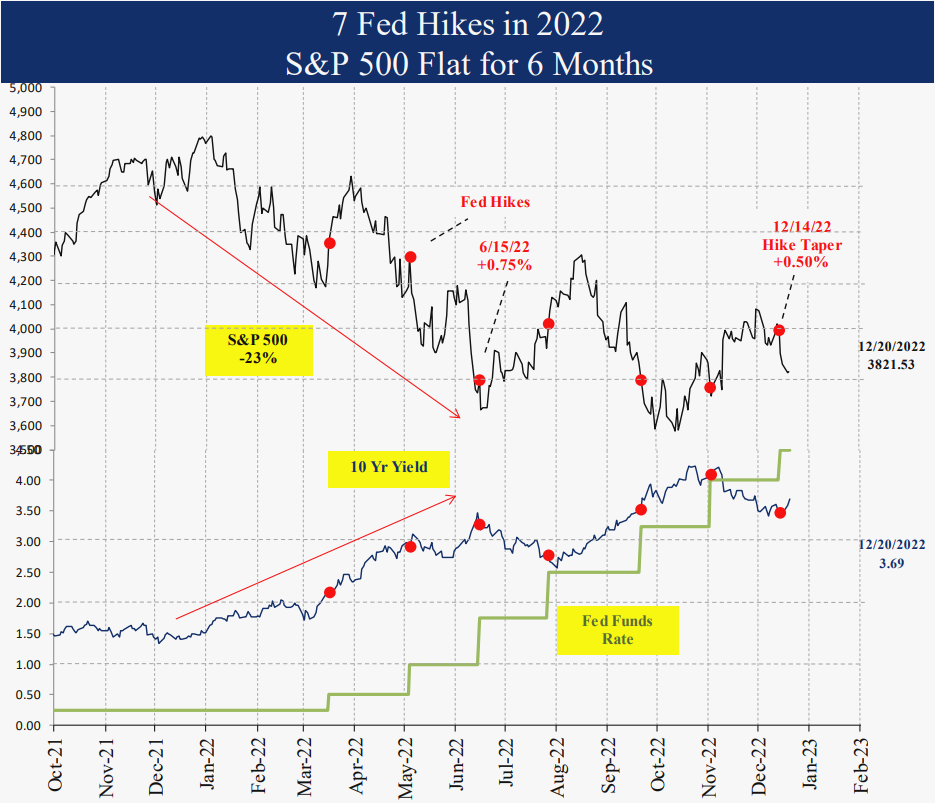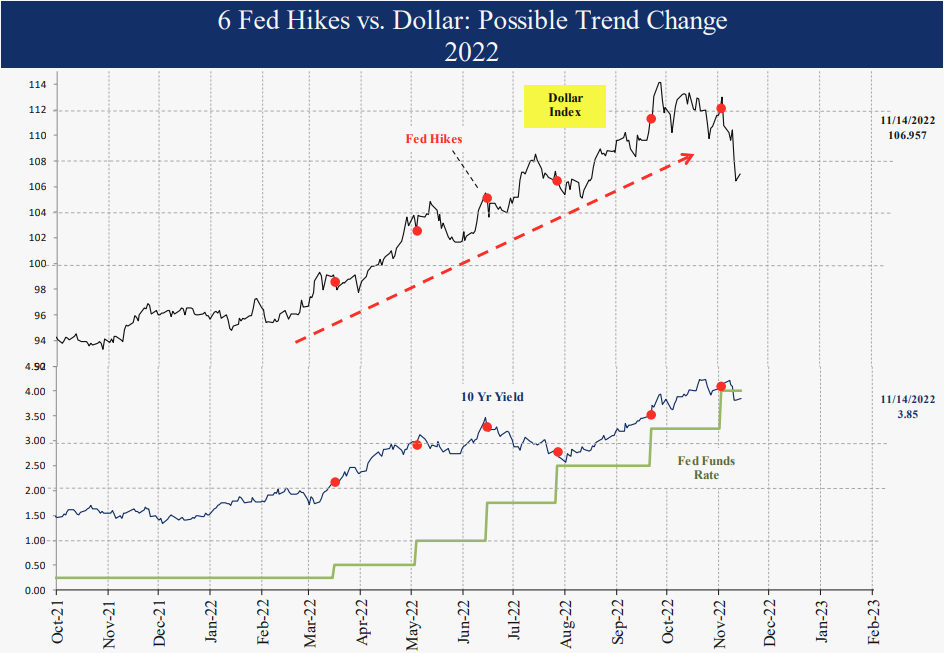Economic Turning Point – January 20. 2022
Last month we discussed the peak hawkishness shift away from the U.S. Federal Reserve to Europe and Japan instead, confirming the major dollar reversal, now down 10.9% from the September peak. The implications of a weak dollar are already playing out in the recent surge in foreign equities and commodities like gold and copper. We also discussed the extreme investor positioning in U.S. equities setting up for a strong start to the year. This month we compare economic conditions to the recession consensus, along with some rare but potent technical market developments. The implications for investors are significant, primarily bullish for equities and commodities and negative for bonds.
We cut long-term bonds to a cautious 2 rating. U.S., foreign-developed, and emerging markets equities remain bullish 5 ratings. Gold and commodities remain bullish 5 ratings as well.
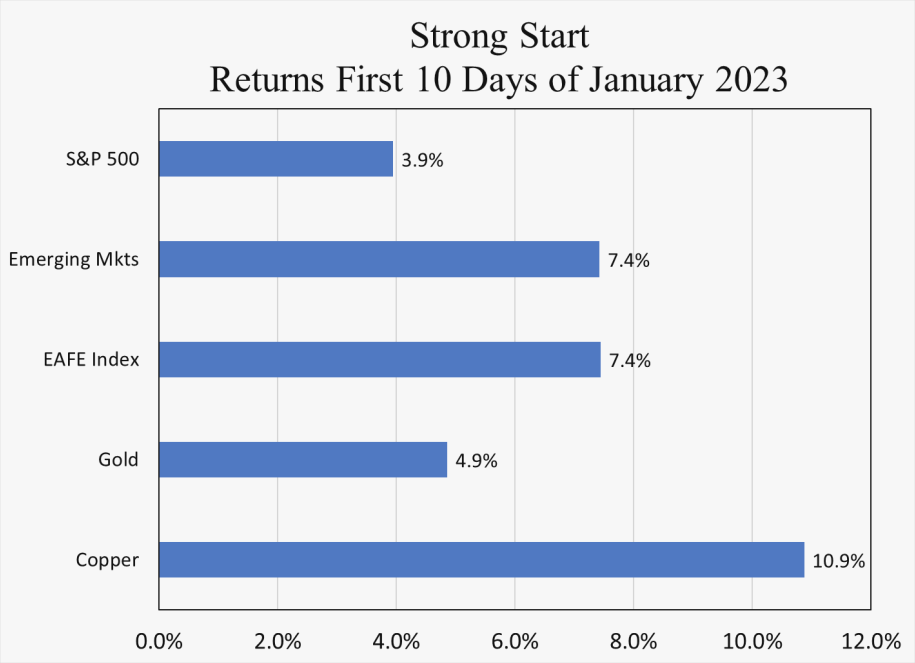
Economic Outlook Uptick: Long-Term Bond Yields Higher
Although bond indicators were bullish in October when the 10-year yield peaked at 4.3%, today the situation is reversed. Since the yield peak when there were forecasts of 5% by year end, investors bought bonds as a consensus formed around a 2023 recession ahead, confirmed by economists and pundits daily. In response, the 10-year yield declined 90 basis points to 3.40% as of 1/18/23. Between the Fed hiking aggressively and the perfect record of the inverted yield curve, a 2023 recession is now such a fact for investors that the only debate is how deep it will be. The better question for bond investors is not recession or no recession, but instead the near-term direction of the economy.
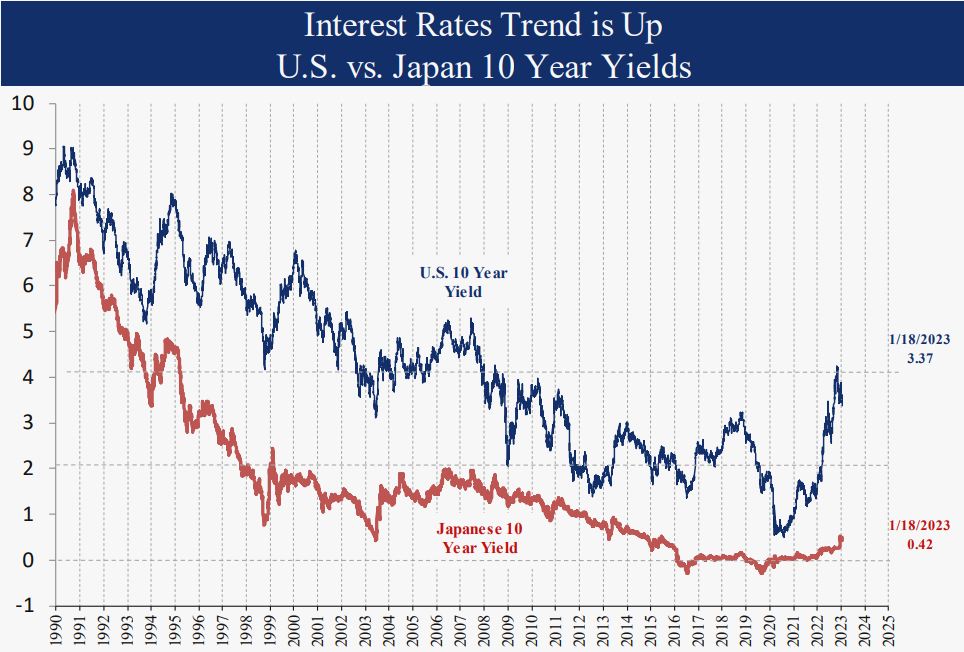
Although the global economy has certainly slowed in the last 12 months by almost any measure, there are preliminary indications the next move will be to the upside instead. High frequency economic outlook indicators are improving fast. For instance, the CRB industrials commodity index is now up for the third month in a row. Copper actually bottomed 6 months ago in July and is up 26% since November. Our economic outlook indicators are still neutral at 53 but they are up over 20 points from the low of 30 last July. Finally, the EAFE Index (Europe, Asia and the Far East) equity index is up 7.4% in just the first two weeks of the year. These signals are inconsistent with an imminent recession. Markets could be anticipating China reopening or even a European economic recovery. Even with inflation falling, the 10-year yield is still 3% below the inflation rate compared to a norm of 2% over. This means bonds are at risk of a move higher in yield, lower in price. This month we cut our long-term bond rating to a cautious 2.
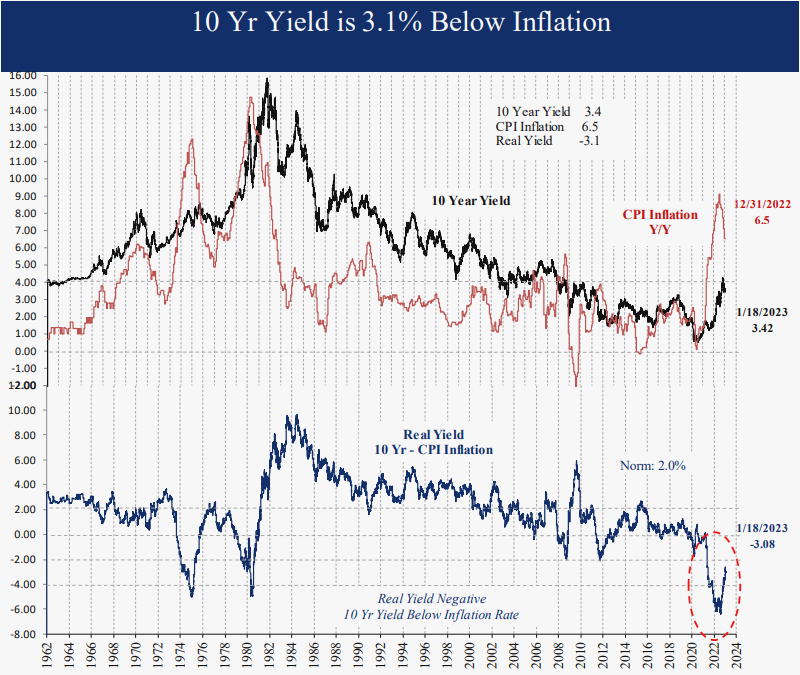
Strong Start to January is Bullish
There are many versions of the so-called January effect. This year the S&P 500 was up 1.4% in the first 5 days of the year. It does not seem like a particularly meaningful move, but historically it was quite positive for the S&P 500 going forward. The theory is that if money is put to work in the first week of the year, there is likely more to come afterwards. With the extreme investor positioning going into year end we discussed last month, this reversal of flows could have a long way to go. For instance, 2 months out the average return of the 29 prior cases since 1950 was 4.0%, over 2x the norm, and 82% of the cases were higher. The worst case was 2003 which was down 11% 2 months out, but finished the year up 26%.
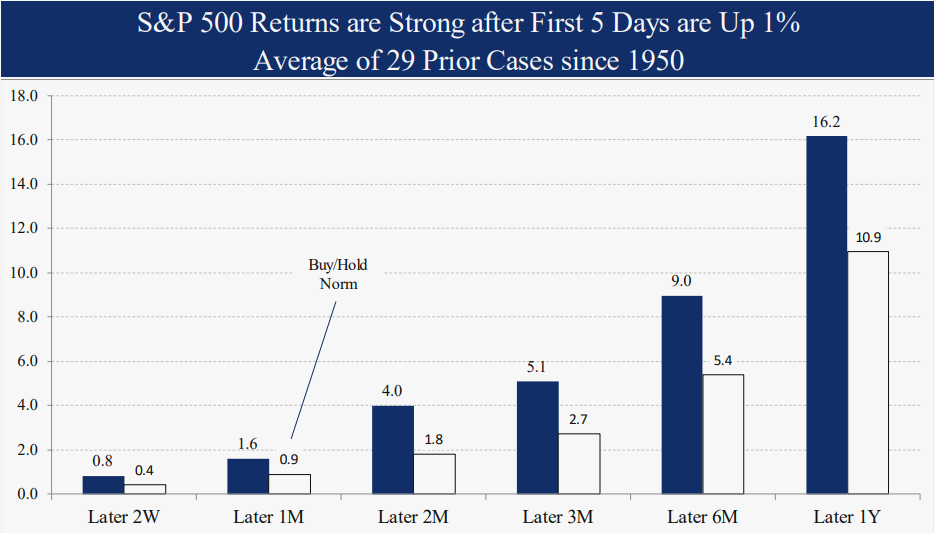
Breadth Thrust Bullish for Equities
Aside from the strong start to January, there was also a rare breadth thrust on January 12th. This one is a version of a technical indicator developed by Martin Zweig which measures the average number of advancing stocks compared to decliners over a 10-day period. On 1/12/23 it reached 2:1 to the upside, meaning there was very strong and sustained buying that occurred over a twoweek period. The theory is such strong buying pressure is a signal of more to come.
After the 16 prior cases since 1950, the S&P 500 was significantly higher, beating the buy and hold norm by a wide margin. For instance, just a month later the average return was 3.8%, over 4x the norm. 6 months out, the average return was 17.6% and 23.2% a year out. The next 10% move was up in all prior cases.
In 4 of those cases, like this year, there was a combination of the first 5 days higher AND a January breadth thrust; in 1975, 1976, 1987 and 2019. These cases were particularly strong for the S&P 500. All were higher 6 months later by an average of 20.7%. These technical developments strengthen our bullish 5 rating on U.S. equities.
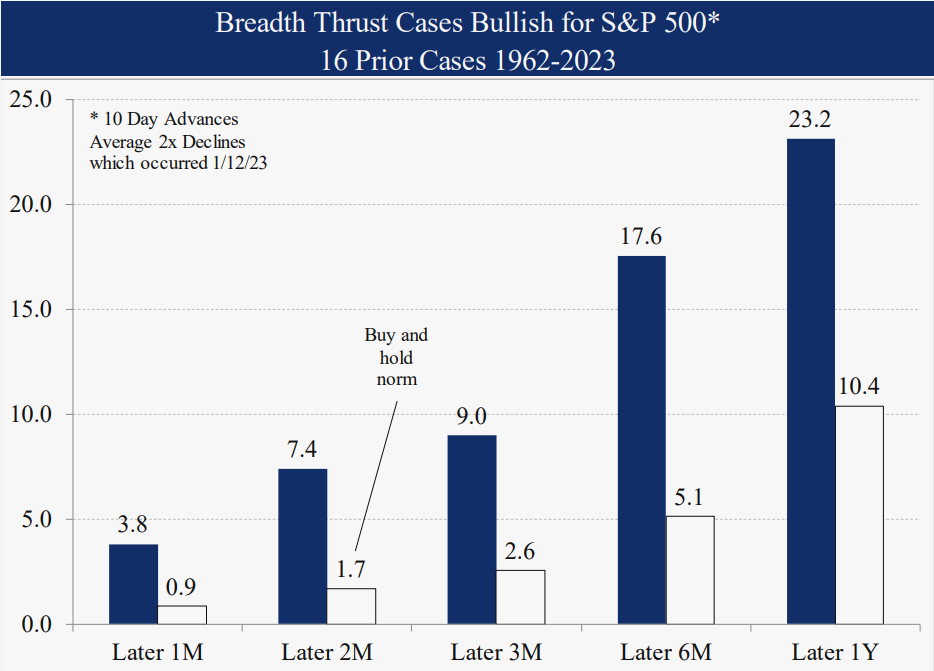
Inflation and Fed Funds Converging: Fed Policy Off the Table
Inflation continued lower in December to 6.5%, an even faster decline than the norm after prior CPI peaks. Inflation outlook indicators predict more to come. After hitting 45 in September, they are reading 40 today. The Fed softened their rhetoric at the December FOMC, suggesting smaller hikes and a pause would be appropriate at some point. With inflation falling and the Fed Funds target expected to rise to 5% by May, inflation is likely to cross below the Fed Funds target by June, which validates the Fed’s softening view. The likely pause also explains the dollar reversal, since it demonstrates how peak hawkishness has shifted to the ECB, when Lagarde stated in December that the ECB has more work to do. She confirmed this view on 1/19/23 in Davos where she stated “inflation by all accounts, whichever way you look at it, is way too high.”
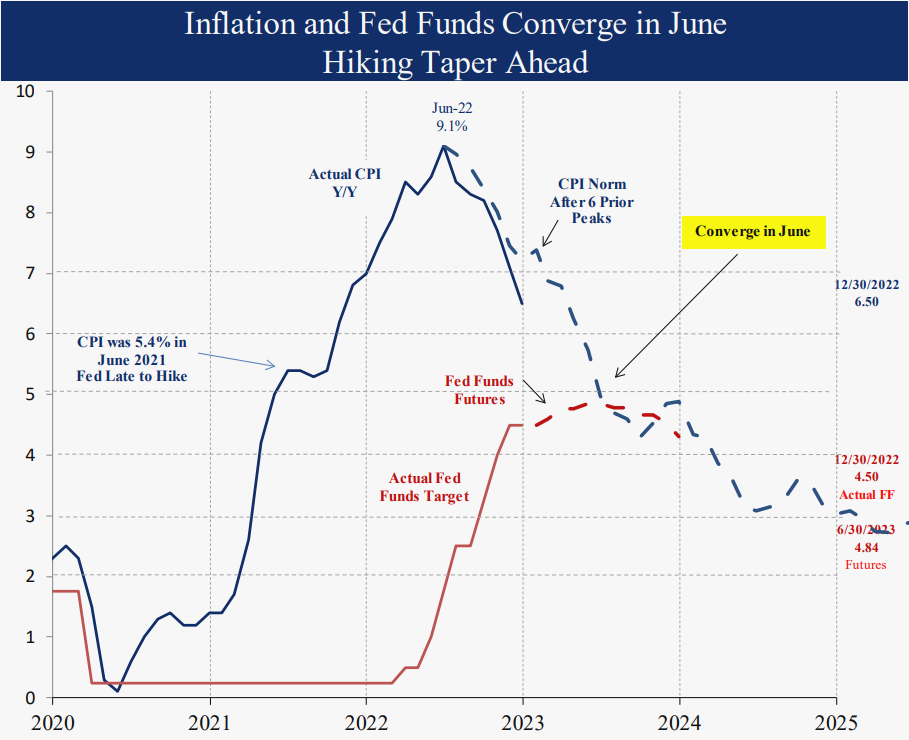
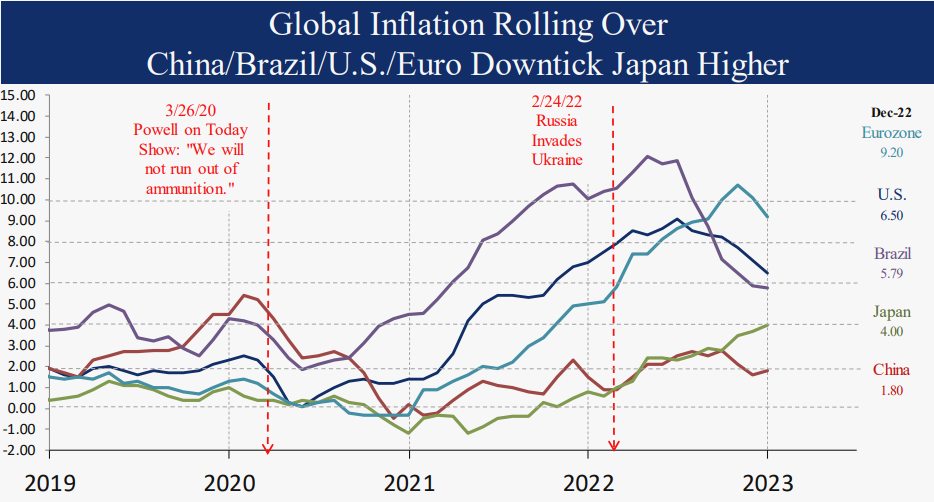
Conclusion
This month we discussed the uptick in some high frequency economic outlook indicators. With such a strong consensus expecting a recession this year, a stronger economy instead would move prices sharply, particularly bonds (down) and equities and commodities (up). The combination of high but falling inflation and a decline in the 10-year yield was bullish historically, even when the Fed was hiking rates as they are today. Gold, industrial commodities, emerging markets and foreign equities are already reacting to the upside from the 10% dollar reversal. A stronger than expected global economy would only add fuel to those rallies. Finally, lower inflation is playing out as expected, effectively taking the U.S. Fed out of the equation with a Fed pause by May even more likely after the December CPI release. A contrarian position is never easy and not always warranted, but today it is supported by the evidence. We will continue to monitor our indicators on a daily basis for changes to our outlook. Thank you for your support and please contact us with any questions.
IMPORTANT DISCLOSURES
This review and outlook report (this “Report”) is for informational, illustration and discussion purposes only and is not intended to be, nor should it be construed as, financial, legal, tax or investment advice, of Brenton Point Wealth Advisors LLC or any of its affiliates (“Brenton Point”). This Report does not take into account the investment objectives, financial situation, restrictions, particular needs or financial, legal or tax situation of any particular person and should not be viewed as addressing any recipient’s particular investment needs. Recipients should consider the information contained in this Report as only a single factor in making an investment decision and should not rely solely on investment recommendations contained herein, if any, as a substitution for the exercise of independent judgment of the merits and risks of investments.
This material is based upon information obtained from various sources that Brenton Point believes to be reliable, but Brenton Point makes no representation or warranty with respect to the accuracy or completeness of such information. Views expressed herein are current only as of the date indicated and are subject to change without notice.
This Report contains certain forward looking statements opinions, estimates, projections, assessments and other views (collectively “Statements”). These Statements are subject to a number of assumptions, risks and uncertainties which may cause actual results, performance or achievements to be materially different from future results, performance or achievements expressed or implied by these forward looking statements and projections. Brenton Point makes no representations as to the reasonableness of such assumptions or the likelihood that such assumptions will coincide with actual events and this information should not be relied upon for that purpose. Changes in such assumptions could produce materially different results. Past performance is not a guarantee or indication of future results, and no representation or warranty, express or implied, is made regarding future performance of any financial instrument mentioned in this Report.
Any benchmark shown herein is shown for illustrative purposes only. No index benchmark is available for direct investment. It may not be possible to replicate the returns of any index, as the index may not include any trading commissions and costs or fees, may assume the reinvestment of income, and may have investment objectives, use trading strategies, or have other materials characteristics, such as credit exposure or volatility, that do not make it suitable for a particular person. This is not an offer or solicitation for the purchase or sale of any security, investment, or other product and should not be construed as such. References to specific financial instruments and to certain indices are for illustrative purposes only and provided for the purpose of making general market data available as a point of reference only; they are not intended to be, and should not be interpreted as recommendations to purchase or sell such securities. Investing in securities and other financial products entails certain risks, including the possible loss of the entire principal amount invested, as the value of investment can go down as well as up. You should obtain advice from your tax, financial, legal, and other advisors and only make investment decisions on the basis of your own objectives, experience, and resources.
Brenton Point accepts no liability for any loss (whether direct, indirect or consequential) occasioned to any person acting or refraining from action as a result of any material contained in or derived from this Report, except to the extent (but only to the extent) that such liability may not be waived, modified or limited under applicable law.
This Report may provide addresses of, or contain hyperlinks to, Internet websites. Brenton Point has not reviewed the linked Internet website of any third party and takes no responsibility for the contents thereof. Each such address or hyperlink is provided solely for your convenience and information, and the content of linked third party websites is not in any way incorporated herein. Recipients who choose to access such third-party websites or follow such hyperlinks do so at their own risk.
All marks referenced herein are the property of their respective owners. This Report is licensed for non-commercial use only, and may not be reproduced, distributed, forwarded, posted, published, transmitted, uploaded or otherwise made available to others for commercial purposes, including to individuals within an institution, without written authorization from Brenton Point.
Source of data and performance statistics: Bloomberg L.P. and Factset Research Systems Inc.
©Brenton Point Wealth Advisors LLC 2023

Michael Schaus
Director of Market Research
Michael Schaus is the Director of Market Research for Brenton Point Wealth Advisors and Zweig-DiMenna. Since joining Zweig-DiMenna in 1992, his focus has been on macroeconomic research, the analysis of…
READ MORERead Next:
Sign up!
Sign up for our monthly newsletter and get the lastest news and research from our esteemed advisors here at Brenton point. Right into your inbox!


 Client Login
Client Login

